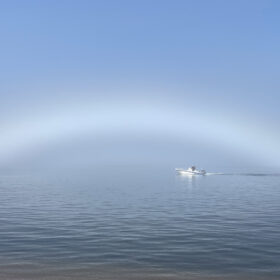By Pat Foster-Turley
January 6, 2023

These days, going to the beach this time of year for many involves fossilized shark tooth hunting and little else. Whenever I walk on the beach I am amazed at all of the people walking along slowly, watching their own steps, seeking these tiny marvels of nature. Many different shark tooth finding strategies are in place. Some carry shark tooth “pick up devices” to lift their possible finds up to eye level without stooping. Some people find one spot to focus on, and dig holes there. And at least one enterprising collector I watched was crawling down the beach on his hands and knees, with knee pads and heavy gloves to protect his joints. “You look like an ape-man walking on his knuckles,” I told him, and he laughed in response. But he did look like that! Whatever it takes to find some tiny object with no tangible value is the mantra here now.
But wow, are these people missing a lot in their narrow-minded focus. On a recent visit around the jetties of Fort Clinch—a favored hunting spot—I didn’t find any teeth at all. I did look where I stepped just in case, but I also savored the views of the ocean in and out of a ghostly fog that obscured, then revealed Cumberland Island. And I was thrilled by an almost-rainbow that appeared over the water, highlighting a passing boat. No one else I saw even noticed it, so intent were they on their shark tooth mission.

What I did find by looking down was a bunch of strange holes in the sand surrounded by tiny uniform cylindrical objects about the size, shape and color of chocolate candy sprinkles. I did some Googling and found that these are fecal pellets deposited by ghost shrimp. These 4- or 5-inch-long fragile shrimp are rarely seen because for the most part they live far underground in a system of tunnels they build that may be as much as 16 feet below the surface of the beach. When the tides recede the shrimp use their paddle-like legs to push water out of their burrows, and along with the water comes their accumulated fecal pellets and a burrow free of feces, at least for a while.
Although until now I wasn’t familiar with ghost shrimp, back when I routinely walked miles on our beaches at dawn I often encountered another crustacean cousin, ghost crabs. Unlike the ghost shrimp, these crabs exit their holes in the sand and walk around the beach, finding things to eat mostly at night, although some are still out and about at dawn before scurrying down their holes again.

Ghost crabs are not particular about where they make their holes, or maybe they are oblivious to the happenings above them when they are underground during the day. I can just imagine the surprise of one particular ghost crab that emerged from its burrow on Main Beach to find a “Christmas tree” made of painted shells right above it. But hey, it just went with the flow and continued to live there through the holiday season.

The Amelia Shells Christmas tree is a seasonal event that aims to bring joy to people who can admire it on the beach. Although signs discourage people from taking the “ornaments” on the tree (the very artistic shells that highlight the green oyster shell background), people still did. And, worse yet, the Amelia Shell volunteers worked hard to keep painting enough shells to give away to people in two boxes clearly marked, “Please take only one.” But some people disregarded this message and greedily took handfuls at a time, depleting the shell supply quickly when the volunteers added new batches. How can anyone feel OK about removing handfuls of free, painstakingly painted shells, and depriving others of the joy of obtaining just one? But luckily there was lots of good coming out of the Amelia Shell tree too. Some people even took to painting their own shells and adding them to the tree. Good for them!
There are a few ghosts on the beach—the fog, the shrimp, and the crabs—but just maybe there is also a “Christmas Ghost” that is roaming around to chastise some people for their greediness and to reward others for their kindness. One can only hope.
Pat Foster-Turley, Ph.D., is a zoologist on Amelia Island. She welcomes your nature questions and observations. [email protected].

Excellent perspective, Pat. You see things that nearly everyone misses, and you describe in great scientific detail what you’ve observed. Kudos on another great column.